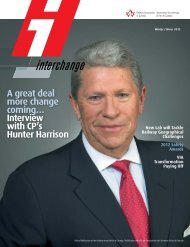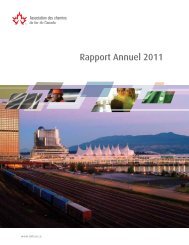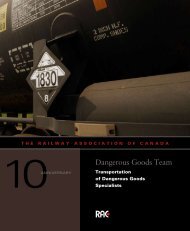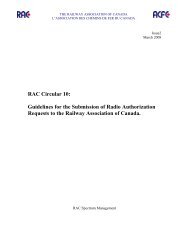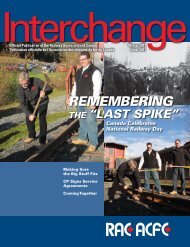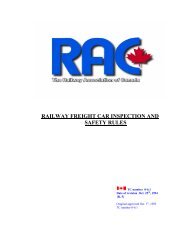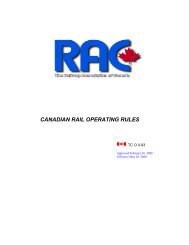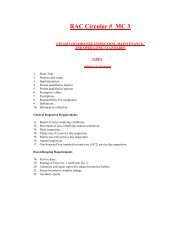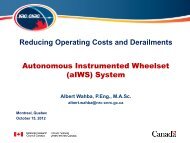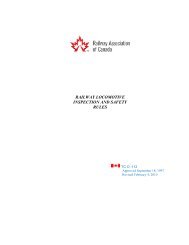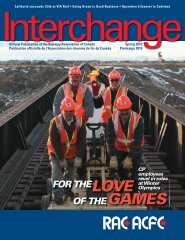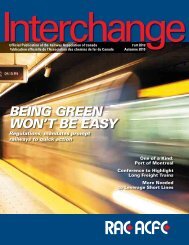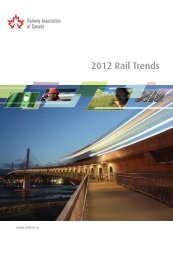Locomotive Emissions Monitoring Program - Railway Association of ...
Locomotive Emissions Monitoring Program - Railway Association of ...
Locomotive Emissions Monitoring Program - Railway Association of ...
Create successful ePaper yourself
Turn your PDF publications into a flip-book with our unique Google optimized e-Paper software.
2.3.1<br />
Freight Operations<br />
Fuel consumption in 2008 for all freight train, yard switching and work train operations was 2,077.96 million litres,<br />
a drop <strong>of</strong> 2.7 per cent from the 2,134.92 million L consumed in 2007 but 6.1 per cent over the 1990 level <strong>of</strong><br />
1,957.96 million L. The trend since 1990 in overall freight operations fuel consumption is shown in Figure 8.<br />
Figure 8<br />
Freight Operations Fuel Consumption<br />
Litres (million)<br />
2500<br />
2,500<br />
6.1 per cent increase over 1990<br />
2000<br />
2,000<br />
1500<br />
1,500 1990 91 92 93 94 1995 96 97 98 99 2000 01 02 03 04 2005 06 07 08<br />
A measure <strong>of</strong> freight traffic fuel efficiency is the amount <strong>of</strong> fuel consumed per 1,000 RTK. As shown in Figure 9, this<br />
value for freight traffic in 2008 was 6.16 L per 1,000 RTK compared to 5.90 L per 1,000 RTK in 2007. It has decreased<br />
from 7.83 L per 1,000 RTK in 1990.<br />
As a percentage, freight traffic fuel consumption per 1,000 RTK in 2008 was 4.3 per cent above the 2007 level.<br />
This reversal in trend from previous years was due to the economic downturn that came into effect in 2008. However,<br />
the 2008 level was still 21.3 per cent lower than in that <strong>of</strong> 1990 which shows the ability <strong>of</strong> the Canadian freight<br />
railways to accommodate traffic growth while reducing fuel consumption per unit <strong>of</strong> work.<br />
Figure 9<br />
Freight Fuel Consumption per 1,000 RTK<br />
Litres<br />
10.0<br />
10.00<br />
21.3 per cent reduction since 1990<br />
7.5<br />
7.50<br />
5.0<br />
5.00 1990 91 92 93 94 1995 96 97 98 99 2000 01 02 03 04 2005 06 07 08<br />
This improved fuel efficiency by Canadian freight railways has been achieved primarily by replacing older locomotives<br />
with modern fuel-efficient EPA compliant locomotives. As well, operating practices that reduce fuel consumption<br />
are being focused upon and evaluated. Section 7 <strong>of</strong> this report discusses the fuel consumption reduction initiatives<br />
implemented or under examination in 2008.<br />
Table 3 shows the freight operations fuel consumption by service type for 2008 compared to years 2003 through<br />
2007. Of the total diesel fuel consumed in freight operations in 2008, Class I freight trains accounted for 91.6 per<br />
cent, Regional and Short Lines 5.4 per cent and Yard Switching and Work Train 3.0 per cent. Of note from Table 2 and<br />
Table 3 data, due to operational changes resulting in reduced switching activities, the percentage consumed by Yard<br />
Switching and Work Train operations <strong>of</strong> total freight train operations has been reducing steadily<br />
9 LEM 2008




